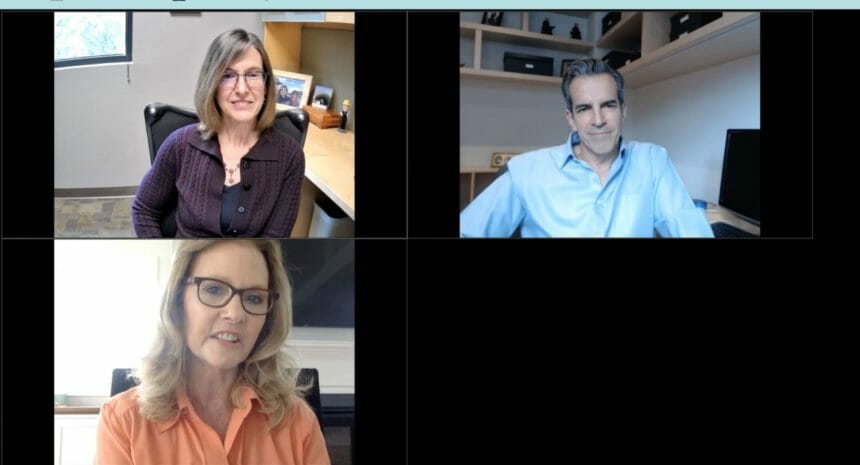
The “ugly period” of the COVID-19 pandemic is behind the senior living industry, but a couple of “COVID hangovers” will persist moving forward, according to industry experts.
“Hero” pay and price gouging will not continue, the cost of test kits is coming down, and some operators have received government relief dollars for personal protective equipment, Colleen Blumenthal, chief operating officer and partner of HealthTrust, a Sarasota, FL-based healthcare real estate advisory firm, said during an inaugural webinar hosted by the American Seniors Housing Association on “The Financial Impact of COVID-19 on Senior Living Communities.”
Liability is a ticking time bomb as insurance premiums increase and COVID carve-outs surface, Blumenthal said. And occupancy, she predicted, will take longer to recover than the four months it spent in flux.
Bill Sciortino, chief operating officer of Florida-based Discovery Senior Living, said that concerns include increased government scrutiny, staffing, a potential “twindemic” of flu and COVID-19, and coaxing people back to senior living after they settled in at home.
“Is there a time when the federal government just gave money and went away?” he said. “I’m worried we are going to have some additional scrutiny or regulation coming our way as an industry because we’ve attracted attention and now we have money.”
As she did at Argentum’s recent annual conference, Blumenthal shared results of a HealthTrust survey on the financial effects of COVID-19; it included 30 operators representing more than 180,000 units. Several universal themes emerged, she said, including occupancy decreases, significant labor cost increases, significant compression on margins, net operating incomes that were lower than budgeted, and expense increases not only in PPE, but in a variety of areas, including dietary supplies, visitation tents, third-party cleaning and fogging services, polycarbonate dividers, electrostatic sprayers, and more.
Not all experiences were universal, however, Blumenthal said. Occupancy decreases ranged from more than 900 basis points to less than 100 basis points. Approximately 21% of respondents reported labor costs at or below budget, whereas others reported costs that ran as high as 8% of revenues.
Testing also revealed wide swings of experiences, with some operators reporting spending less than $500 per week and others reported spending thousands of dollars per week. And net operating income losses ranged from 15% to 55%.
“It was an ugly period,” Blumenthal said, adding that the “worst is behind us. But going forward, there will be a couple of COVID hangovers.”
Kathryn Sweeney, co-founder and managing partner of Blue Moon Capital Partners, a Massachusetts-based real estate investment advisory firm, said that the past several months fell into three phases: shock and awe, setting in and cautious optimism.
The shock and awe phase, she said, included “a real scramble” for PPE and testing.
“The federal government was competing with states competing with operators,” Sweeney said. “It was figuring out testing protocols — how can you get a test, where can you get a test. I talked to one operator who went through a Google search to find a lab to access tests.”
The settling in phase, Sweeney said, saw lab relationships established, PPE sourced, “hero” pay set up, training refreshed and the ability to operate and reopen to new residents. Sciortino described this phase as having data to drive decisions.
August ushered in the “cautious optimism” phase, Sweeney said. Now, government relief funding is in place, rapid antigen tests are available, and therapeutics and vaccines are in phase 3 trials.
“We’re getting back to operating. We’re not just COVID,” Sciortino said. “We will need to clean the kitchen floor, we need to have a great meal service, we need to push our capital projects through, we need to get back into preventive maintenance and shift our operators thoughts back from just COVID to, again, good old-fashioned operating quality.”
Investors are evaluating operators on how they handled the pandemic and how they mitigated COVID-19 cases in their communities, Sweeney said.
They are “really getting under the hood and understanding the details behind the numbers and how the organization supported those successful outcomes is what we’re looking at,” she said.
Sciortino said that a lesson for the industry is to be nimble.
“We have a real challenge, as the operators and investors and owners, to be nimble, to be changing without giving our residents whiplash,” he said. “They don’t want to change. We need to be paddling furiously under the water so we’re making changes.”
The webinar was the first of three in a “Where You Live Matters” series from ASHA. Future webinars will focus on how to better adapt sales and marketing, and how to adjust to the “new normal” in the wake of COVID-19.


